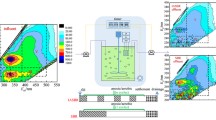Abstract
This study aimed to find optimal operation conditions for nitrogen removal from high strength slaughterhouse wastewater at 11 °C using the intermittently aerated sequencing batch reactors (IASBRs) so as to provide an engineering control strategy for the IASBR technology. Two operational parameters were examined: (1) loading rates and (2) aeration rates. Both the two parameters affected variation of DO concentrations in the IASBR operation cycles. It was found that to achieve efficient nitrogen removal via partial nitrification–denitrification (PND), “DO elbow” point must appear at the end of the last aeration period. There was a correlation between the ammonium oxidizing bacteria (AOB)/nitrite oxidizing bacteria (NOB) ratio and the average DO concentrations in the last aeration periods; when the average DO concentrations in the last aeration periods were lower than 4.86 mg/L, AOB became the dominant nitrifier population, which benefited nitrogen removal via PND. Both the nitrogen loading rate and the aeration rate influenced the population sizes of AOB and NOB. To accomplish efficient nitrogen removal via PND, the optimum aeration rate (A, L air/min) applied can be predicted according to the average organic loading rates based on mathematical equations developed in this study. The research shows that the amount of N2O generation in the aeration period was reduced with increasing the aeration rate; however, the highest N2O generation in the non-aeration period was observed at the optimum aeration rates.





Similar content being viewed by others
References
Environmental Protection Agency (EPA) (2013) http://www.epa.ie/terminalfour/ippc/ippc-search.jsp?class-of-activity=Food+and+Drink&status=Licenced&county=%25&Submit=Search+by+Combination
Commission European (2005) Integrated pollution prevention and control: reference document on best available techniques in the slaughterhouse and animal by-products industries. European Commission, Brussels
Nacheva PM, Pantoja MR, Serrano EAL (2011) Treatment of slaughterhouse wastewater in upflow anaerobic sludge blanket reactor. Water Sci Technol 63:878–885
Rajakumar R, Meenambal T, Saravanan PM, Ananthanarayanan P (2012) Treatment of poultry slaughterhouse wastewater in hybrid upflow anaerobic sludge blanket reactor packed with pleated poly vinyl chloride rings. Bioresour Technol 103:116–122
Rajakumar R, Meenambal T, Banu JR, Yeom IT (2010) Treatment of poultry slaughterhouse wastewater in upflow anaerobic filter under low upflow velocity. Int J Environ Sci Technol 8:149–158
Ruiz I, Veiga MC, de Santiago P, BlazquezR (1997) Treatment of slaughterhouse wastewater in a UASB reactor and an anaerobic filter. Bioresour Technol 60: 251–258
Borja R, Banks CJ, Wang A (1995) Effect of organic loading rate on anaerobic treatment of slaughterhouse wastewater in a fluidized-bed reactor. Bioresour Technol 52:157–162
Saddoud A, Sayadi S (2007) Application of acidogenic fixed-bed reactor prior to anaerobic membrane bioreactor for sustainable slaughterhouse wastewater treatment. J Hazard Mater 149:700–706
Barber WP, Stuckey DC (2000) Nitrogen removal in a modified anaerobic baffled reactor (ABR). Water Res 34:2413–2422
Cao W, Mehrvar M (2011) Slaughterhouse wastewater treatment by combined anaerobic baffled reactor and UV/H2O2 processes. Chem Eng Res Design 89:1136–1143
Zhan X, Healy MG, Li J (2009) Nitrogen removal from slaughterhouse wastewater in a sequencing batch reactor under controlled low DO concentrations. Bioproc Biosyst Eng 32:607–614
Dytczak MA, Londry KL, Oleszkiewicz JA (2008) Activated sludge operational regime has significant impact on the type of nitrifying community and its nitrification rates. Water Res 42:2320–2328
Zhang M, Lawlor PG, Li J, Zhan X (2012) Characteristics of nitrous oxide (N2O) emissions from intermittently-aerated sequencing batch reactors treating the separated liquid fraction of anaerobically digested pig manure. Water Air Soil Pollut 223:1973–1981
Li J, Elliott D, Nielsen M, Healy MG, Zhan X (2011) Long-term partial nitrification in an intermittently aerated sequencing batch reactor (SBR) treating ammonium-rich wastewater under controlled oxygen-limited conditions. Biochem Eng J 55:215–222
Pan M, Henry LG, Liu R, Huang X, Zhan X (2014) Nitrogen removal from slaughterhouse wastewater through partial nitrification followed by denitrification in intermittently aerated sequencing batch reactors at 11 °C. Environ Technol 35:470–477
American Pubilc Health Association (APHA) (1995) Standard methods for the examination of water and wastewater. APHA, Washington
Wu G, Rodgers M, Zhan X (2008) Nitrification in sequencing batch reactors with and without glucose addition at 11 °C. Biochem Eng J 40:373–378
Quan X, Zhang M, Lawlor PG, Yang Z, Zhan X (2012) Nitrous oxide emission and nutrient removal in aerobic granular sludge sequencing batch reactors. Water Res 46:4981–4990
Datta T, Liu Y, Goel R (2009) Evaluation of simultaneous nutrient removal and sludge reduction using laboratory scale sequencing batch reactors. Chemosphere 76:697–705
Krishna C, van Loosdrecht MCM (1999) Effect of temperature in storage polymers and settleability of activated sludge. Water Res 33:2374–2382
Huang X, Gui P, Qian Y (2001) Effect of sludge retention time on microbial behaviour in a submerged membrane bioreactor. Process Biochem 36:1001–1006
Peng Y, Zhu G (2006) Biological nitrogen removal with nitrification and denitrification via nitrite pathway. Appl Microbiol Biotechnol 73:15–26
Tokutomi T (2004) Operation of a nitrite-type airlift reactor at low DO concentration. Water Sci Technol 49:81–88
Acknowledgments
The authors would like to thank the financial support provided by the China Scholarship Council (CSC), the Department of Civil Engineering, NUI Galway, and National High Technology Research and Development Program of China (2012AA06A304).
Author information
Authors and Affiliations
Corresponding authors
Rights and permissions
About this article
Cite this article
Pan, M., Hu, Z., Liu, R. et al. Effects of loading rate and aeration on nitrogen removal and N2O emissions in intermittently aerated sequencing batch reactors treating slaughterhouse wastewater at 11 °C. Bioprocess Biosyst Eng 38, 681–689 (2015). https://doi.org/10.1007/s00449-014-1307-1
Received:
Accepted:
Published:
Issue Date:
DOI: https://doi.org/10.1007/s00449-014-1307-1




